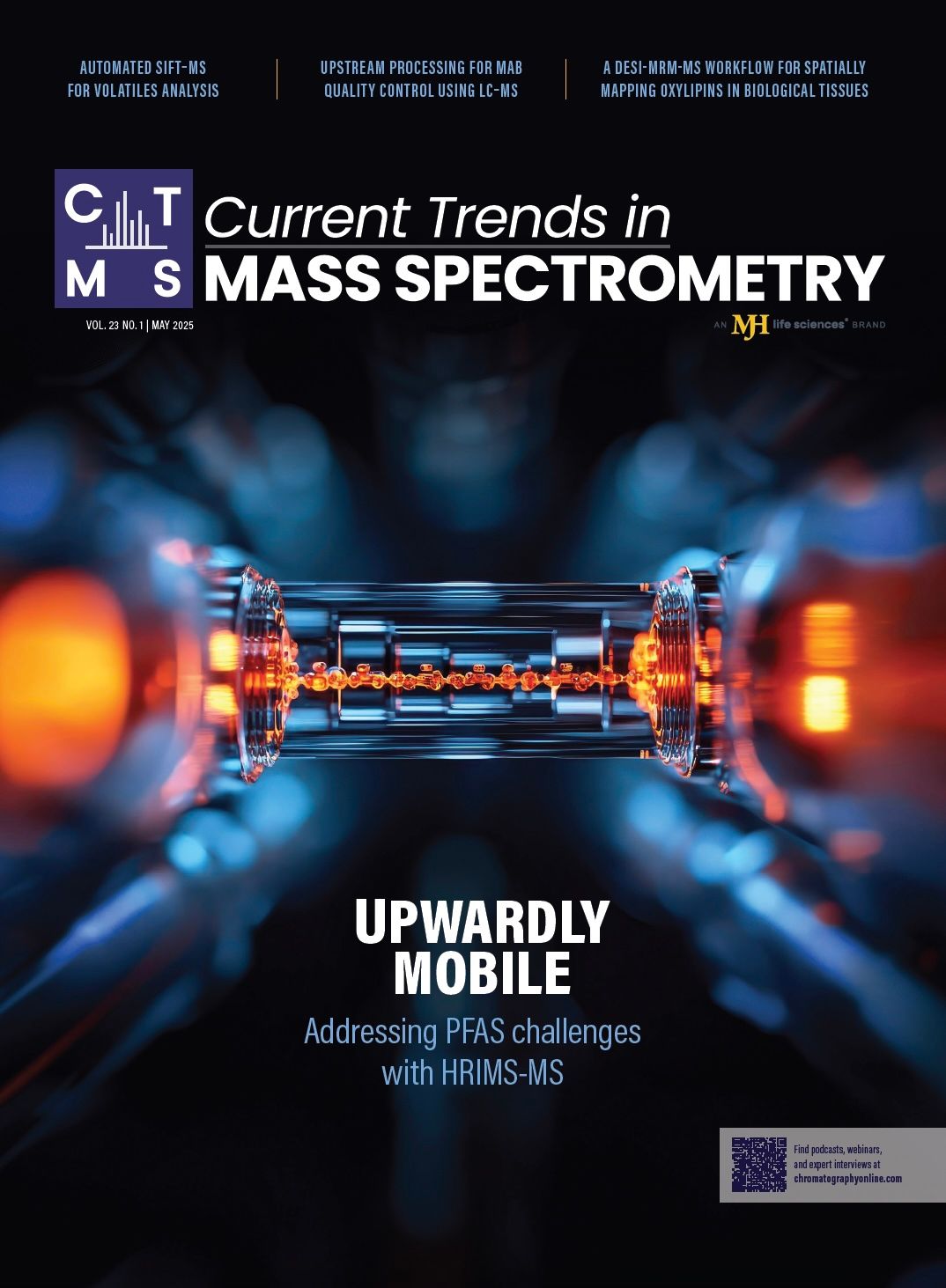Desorption Electrospray Ionization-Multiple-Reaction-Monitoring Mass Spectrometry Workflow for Spatially Mapping Oxylipins in Biological Tissues
LCGC International spoke to Craig Wheelock and Matthew Smith from the Wheelock Laboratory at the Karolinska Institute, Sweden, about a novel desorption electrospray ionization–multiple-reaction-monitoring mass spectrometry (DESI-MRM-MS) workflow his team has developed to spatially map oxylipins in pulmonary tissue.
LCGC International spoke to Craig Wheelock and Matthew Smith from the Wheelock Laboratory at the Karolinska Institute, Sweden, about a novel desorption electrospray ionization–multiple-reaction-monitoring mass spectrometry (DESI-MRM-MS) workflow his team has developed to spatially map oxylipins in pulmonary tissue. This study, according to the authors, realizes the potential of targeted mass spectrometry imaging (MSI) to routinely map low-abundance oxylipins with high specificity at scale.
What is desorption electrospray ionization (DESI), and how does it differ from other ionization techniques commonly used in mass spectrometry (MS)?
DESI was developed in 2004 by Zoltan Takats and Graham Cooks (1). The technique involves electrospraying an organic solvent at a surface to form a thin film of charged solvent at the surface. Desorption of analytes occurs at the surface, with the continued impact of the spray causing projection of the charged analyte-solvent clusters to the mass spectrometer. Subsequently evaporation of the solvent and charge transfer ejects charged analyte ions for detection. The DESI sprayer moves over the samples at defined pixel sizes to capture a spectrum and build ion images. In our case, we spray 95% methanol at cryosections of lung tissue to construct a spatial map of oxylipins (or other metabolites). The primary benefits of DESI include the soft ionization, lack of chemical modification (which is necessary for matrix-assisted laser desorption ionization [MALDI]), ease of sample preparation, and relatively low cost.
Human lungs anatomy form lines and triangles, point connecting network on blue background. Illustration vector © pickup - stock.adobe.com

Why did you decide to combine DESI with multiple reaction monitoring mass spectrometry (MRM-MS)?
Combining the DESI ionization source with MRM detection modality increases our signal-to-noise ratio (SNR) to routinely detect low abundant metabolites within tissue. This is particularly beneficial for imaging of oxylipins, which have low endogenous levels. Additionally, the MRM transition gives specificity over MS1 data, which is the norm within the mass spectral imaging (MSI) community.
What applications do you think DESI-MRM-MS could be useful for?
There has been a steady increase in the interest of applications of mass spectrometry imaging. The ability to obtain information on the spatial relationship of molecules is extremely powerful, and as new instrumentation provides increased resolution and ease of use, the applications will continue to rise. Our primary use of the technique is to determine which regions of the airways produce specific metabolites in response to inflammatory challenges. However, this can of course be applied to any tissue. Another clear application of DESI-based imaging is to examine the distribution of drugs (or other exogenous compounds) in a tissue. We are also using it in environmental exposure studies to determine for example where environmental chemicals of concern localize in zebrafish (or other model aquatic organisms).
What are oxylipins and why is studying them important?
Oxylipins are a group of oxygenated compounds formed from fatty acids. The term was initially coined by Mats Hamberg to describe molecules formed by mono- or dioxygenase-catalyzed oxidation of polyunsaturated fatty acids (2), but has since been expanded to generally encompass all oxygenated products of fatty acids from both enzymatic and non-enzymatic sources. Oxylipins consist of multiple subclasses that are defined by the fatty acid substrate, with the 20-carbon-derived eicosanoids being the most studied, but also including the 18-carbon-derived octadecanoids and 22-carbon-derived docosanoids. Numerous oxylipins are biologically active with both autocrine and paracrine signaling activities. There are many studies that show how oxylipins have an important role in diseases, ranging from cardiovascular to Alzheimer’s. In the respiratory field, oxylipins play a causal role in the pathophysiology of asthma, and antagonism of the leukotriene receptor is an important route of disease management for some asthmatics, which is why we have developed the DESI-MRM method to image oxylipins in pulmonary tissue.
What challenges did you encounter when adapting DESI-MRM for the detection of low-abundance oxylipins (3), and how did you optimize sensitivity and specificity for these analytes?
The low SNR of oxylipins with imaging modalities is problematic, and in part explains why these low abundant lipid mediators are not routinely mapped in MSI experiments. We have a long history of experience with these compounds and have dreamed of visualizing them in situ for many years. To optimize the experimental parameters, we used oxylipin analytical standards that we had in our laboratory. We were thus able to optimize the DESI parameters and MRM transitions for each oxylipin in order to maximize sensitivity. Of course, a huge advantage is the inherent MRM detection mode to reduce the chemical noise. A major challenge is that oxylipins have many isomers, so specificity was a problem in the absence of LC separation. We attempted the use of qualifier ions, but for many oxylipins the qualifier ion dropped below the lower limit of detection (LLOD) in some pixels and could therefore not be used. Instead we opted to use LC–MS/MS of analogous tissue to infer the identity of specific isomers within the imaged tissue. Further developments in our laboratory have enabled us to conduct LC–MS/MS of sequential sections from the tissue used for our MSI experiments for improved confidence.
Why is spatially mapping oxylipins in pulmonary tissue important?
The airways are heterogeneous tissue consisting of multiple tissue types with unique cellular populations. Oxylipins, and eicosanoids in particular (prostaglandins, leukotrienes), have known causal roles in the etiology and pathophysiology of respiratory diseases such as asthma. However, it is unclear which cell types are producing which oxylipins under which conditions. Immune cells and structural cells have a demonstrated ability to synthesize oxylipins, but the profiles can differ, particularly in response to external triggers. There have unfortunately been a number of recent failed clinical trials in the development of new drugs to treat asthma. The reasons that the drug candidates did not achieve the expected efficacy are unclear, but I believe that one explanation for the failures is a lack of clarity on the physiological effects associated with the molecular target. The use of DESI-MRM can provide a much deeper understanding of which cell types produce which oxylipins under which conditions and the subsequent effects that a drug exerts in blocking a receptor. Once we are able to develop an appropriate model for human lung tissue, we can perform experiments with ex vivo challenges to map, in detail, the production of oxylipins (and other metabolites) as well as the molecular responses to pharmacological interventions.
How does the spatial resolution achieved by DESI-MRM-MS compare with other MSI methods?
Spatial resolution is a trade-off with acquisition time, which can be drastic (acquisition time increases with square of pixel size), and sensitivity. For screening low abundant oxylipins in large cryosections, we have settled on 30 µm pixels for DESI, which has proven analytically robust and sufficient for understanding the biology in which we are interested. There are reports from groups that have managed to push the spatial resolution to 5 µm, but we have no current plans to attempt this in-house.
In terms of other techniques, with updates to the laser technology, MALDI can achieve resolution below 5 µm pixels, with reasonable sensitivity. Whilst SIMS can offer sub-1-µm resolution, the molecular coverage for biological applications is limited.
Could you elaborate on the key features of the custom-built R package (quantMSImageR) (4) and how it addresses specific challenges in the analysis and visualization of spatial oxylipin distributions?
One of the challenges with the DESI-MRM technique was a lack of software for this novel data modality. Accordingly, one of the first things that we did was develop our own in-house solution, which we called quantMSImageR (and is freely available on github). Within quantMSImageR there is functionality to conduct SNR thresholding, internal standard (IS) normalization, quantification, different visualization strategies, and outputting of data into different modalities. For example, region-of-interest (ROI) vs. metabolite data matrices of average response/concentration to conduct traditional univariate or multivariate metabolomics analyses on ion images and text images. This flexibility of outputs is important for downstream multimodal integration. We are currently updating the functionality to overlay the ion images with hematoxylin and eosin (H&E) stains and spatial transcriptomics within tissUUmaps (developed at Uppsala University) (5). Importantly, the main benefit of using open-source software is our ability to continually develop software to keep up with the needs of our data and biological questions, as well as making our software solutions freely available to the research community.
What new insights into pulmonary tissue lipid metabolism were revealed by this approach that could not be captured by traditional LC–MS/MS?
This part is very much a work in progress. To date, we were able to show that the parenchyma and airways have both overlapping as well as unique production of oxylipin profiles (which was expected). To explore this question in detail, we are working on the development of ex vivo models in which we can challenge human lung tissue with known inflammatory stimuli. This will enable us to map distinct immune cell responses and the associated oxylipin production to, for example, T1 vs T2 inflammation.
What are the current limitations of DESI-MRM-MS in mapping oxylipins at scale, and what future advancements in instrumentation or methodology could address these challenges?
A primary limitation of DESI-MRM-MS is the limit of 32 MRM transitions per acquisition. However, one could argue that the pathways mapped are more important than raw metabolite counts, with DESI-MRM-MS enabling us to routinely map low abundant metabolites and still have sufficient coverage of abundant metabolic pathways.
Additionally, the non-destructive nature of DESI means multiple scans can be taken from the same tissue. However, this increases acquisition time, which is already an order of magnitude greater than bulk analysis. Still it is feasible to perform multiple acquisitions from the same tissue cryosection and thereby increase the number of molecules visualized.
We envision DESI-MRM-MS to be a useful component of multi-model spatial biology efforts. For example, the soft ionization does not significantly affect the RNA integrity enabling the acquisition of spatial transcriptomics from the same cryosection and thus mapping metabolic processes to specific cell types and populations in real physiological context.
What approaches were used to ensure the quantitative accuracy of oxylipin distributions in pulmonary tissue using DESI-MRM-MS, and how were these results validated against LC–MS/MS data?
It is important to highlight that, strictly speaking, DESI-MRM is not quantitative. The quantification that we reported in the article is described as estimated quantification. This is due to the fact that it is not possible to accurately introduce an internal standard into the tissue. We therefore opted to spike calibration standards onto tissue at known concentrations to generate a standard curve. We chose to use liver tissue, which is less heterogeneous than the lung, thereby providing a more reproducible response. The quantified compounds are then reported as pg/pixel (as opposed to pg/mg tissue for LC–MS/MS). To compare the techniques, we performed microdissection of the tissue in airways and parenchyma and quantified the same oxylipins. We found that, generally, LC–MS/MS and DESI-MRM-MS provided similar profiles of observed oxylipins. However, for two oxylipins from the same pathway (11-HETE and TXB2) we found high concentration in an isolated site in the tissue by DESI-MRM, which was missed by LC–MS/MS. This observation demonstrated the utility of spatial mapping vs. analyzing bulk tissue.
How might the ability to spatially map oxylipins in tissues advance our understanding of other inflammatory diseases ?
Our primary interest is to understand which cell types in the lung produce which oxylipins under which conditions. Current approaches to investigating pulmonary biology are based upon either measuring metabolites in systemic samples (blood, urine), in lung fluids (bronchoalveolar lavage fluid), or in bulk tissue (biopsies). While these approaches can all provide physiological insight, they are unable to determine which cells are synthesizing metabolites in response to specific exposures. In other words, we do not have the spatial insight into the relationship between individual cell types, the production of metabolites, and the associated physiological response(s). The application of DESI-MRM-MS will assist in our understanding of inflammatory processes in the airways to better design treatment strategies for respiratory diseases.
What other application areas could benefit from using DESI-MRM-MS for spatial lipidomics?
Interest and application of MSI is increasing substantially and we are seeing numerous advancements in spatial biology. One limitation of much of the current MSI methods is a focus on imaging of high abundant molecules (phospholipids). In addition, these methods are generally based upon MS1-based identification of molecules. The DESI-MRM-MS method offers a complementary approach for imaging molecules with increased sensitivity and specificity. It is therefore well suited for testing focused hypotheses on specific molecules as opposed to HRMS-based MSI methods that serve a role in discovery platforms. A logical workflow includes initial metabolite screening performed with HRMS-based imaging (either DESI or MALDI) and then selection of specific metabolite targets for confirmation with DESI-MRM-MS. This workflow is applicable to essentially any molecule that ionizes by ESI, not just lipids. This could be useful in metabolomics, exposomics, and pharmacological studies.
References
(1) Takáts, Z.; Wiseman, J. M.; Gologan, B.; Cooks, R. G. Mass Spectrometry Sampling Under Ambient Conditions with Desorption Electrospray Ionization. Science 2004, 306 (5695), 471–473. DOI: 10.1126/science.11044
(2) Gerwick, W. H.; Moghaddam, M.; Hamberg, M. Oxylipin Metabolism in the Red Alga Gracilariopsis Lemaneiformis: Mechanism of Formation of Vicinal Dihydroxy Fatty Acids. Arch. Biochem. Biophys. 1991, 290 (2), 436–44. DOI: 10.1016/0003-9861(91)90563-x.
(3) Smith, M. J.; Nie, M.; Adner, M.; Safholm, J.; Wheelock, C. E. Development of a Desorption Electrospray Ionization-Multiple-Reaction-Monitoring Mass Spectrometry (DESI-MRM) Workflow for Spatially Mapping Oxylipins in Pulmonary Tissue. Anal. Chem. 2024, 96 (45), 17950–17959. DOI: 10.1021/acs.analchem.4c02350
(4) GitHub, targeted-lipidomics/quantMSImageR. https://github.com/targeted-xlipidomics/quantMSImageR (accessed 2025-03-14).
(5) Solorzano, L.; Partel, G.; Wahlby, C. TissUUmaps: Interactive Visualization of Large-scale Spatial Gene Expression and Tissue Morphology Data. Bioinformatics 2020, 36 (15), 4363–4365. DOI: 10.1093/bioinformatics/btaa541
Matthew J. Smith © Image courtesy of interviewee

Matthew J. Smith is a postdoctoral researcher at Karolinska Institutet, specializing in analytical and computational workflows for mass spectrometry imaging. His current research focuses on integrating spatial modalities to map lipid dysregulation and toxicokinetics to cellular neighbourhoods using human tissue and zebrafish models.
Craig E. Wheelock © Image courtesy of interviewee

Craig E. Wheelock leads the Unit of Integrative Metabolomics at the Karolinska Institute. His research focuses on mass spectrometry-based approaches to investigate inflammatory processes in the airways towards the goal of identifying molecular phenotypes (metabotypes) and treatable endotypes of asthma.


.png&w=3840&q=75)

.png&w=3840&q=75)



.png&w=3840&q=75)



.png&w=3840&q=75)




